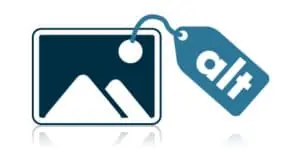Two Tips to improve SEO

SEO Tip #1: Use Alt Tags for Your Images
In SEO, it's easy to get bogged down in complicated strategies and endless tweaking. But there are two simple tips to improve your website's search engine ranking without much extra work.
Alt tags are a crucial element of on-page SEO. They provide a backup description for images that don't display and describe images for visually disabled users. Adding a keyword-rich alt tag that accurately describes the image creates one more potential place for search engines to find and index your content.
Look closely at how to use alt tags and why they're so important.
How to Use Alt Tags
To add an alt tag to an image, you'll need to access the image and look for the field labeled "Alt Text" or "Alternative Text." This field should allow you to enter a brief phrase that describes the image in a concise and informative way.
When creating alt tags, it's essential to keep the following best practices in mind:
- Be descriptive: Your alt tags should accurately describe the image's content. This is important not just for SEO purposes but for accessibility as well. If the image isn't visible, the alt tag should provide enough information for a visually disabled user to understand what the image depicts.
- Use keywords: Just like your website's text content, your alt tags should include relevant keywords that help search engines understand what your page is about. However, don't overdo it – stuffing your alt tags with irrelevant keywords can harm your SEO.
- Be concise: Alt tags should be brief and to the point. Aim for no more than 125 characters to ensure that the entire tag is visible in search engine results.
Why Alt Tags Are Important
There are several reasons why alt tags are so important for SEO:
- They help search engines understand your page: Search engines rely on various signals to understand what your page is about. Alt tags provide one more signal that helps search engines determine what your page is about.
- They improve accessibility: Alt tags help visually disabled users understand what's happening on the page, even if they can't see the images.
- They can drive traffic: If someone is searching for a particular type of image, your alt tag can help your image appear in image search results.
Here's an example of an image with a reasonable alt tag:
<img src="two-point-pencil.jpg" alt="two-point pencil representing two seo tips">
In this case, the alt tag is descriptive and keyword-rich, making it easy for search engines and visually disabled users to understand what the image depicts.

Two-point pencil representing 2 SEO tips
The caption above mirrors what is in the alt tag for this image. The idea is that the pencil has two tips, and so does this blog post.
Added Bonus
Making sure your alt tags have content moves you closer to ADA compliance.
Read more about ADA Web Compliance
SEO Tip #2: Refresh Old Content
If you're looking to create fresh content for search engines without starting from scratch, consider going back to older pages and making some tweaks. Add links to newer content, expand on ideas, add pictures, and make sure to optimize any SEO elements you may have missed. This can boost your content's search engine rankings, primarily if you focus on pages that contain keywords you currently rank on the 2nd or 3rd page of the search engine results.
Here are a few ways to refresh old content and give it a new lease on life:
- Add New Information
- If you wrote a blog post several years ago and new information has come to light since then, update your post to reflect the new information. This could include new studies, new research, or new best practices in your industry.
- For example, let's say you wrote a blog post in 2018 about the benefits of a particular type of exercise. Since then, a new study has shown even more benefits of that exercise. You could update your post with the latest information from the study, optimizing the post with relevant keywords.
- Add More Detail
- If your old content is a bit thin in detail, consider expanding it. This could involve adding more information on a particular topic, including additional tips or strategies, or diving deeper into a particular aspect of your topic.
- For example, suppose you wrote a blog post about how to create a successful social media campaign. In that case, you could add more detail on specific tactics, such as how to use hashtags effectively or create compelling social media graphics. By providing more detailed information, you'll create a more valuable resource for your readers and give search engines more content to index.
- Add Multimedia
- If your old content is heavy on text, consider adding multimedia elements such as images, videos, or infographics. Not only will this make your content more engaging and shareable, it can also help boost your search engine rankings.
- For example, let's say you have a blog post about the best ways to use a particular type of software. You could add screenshots of the software in action, create a video tutorial, or design an infographic that breaks down the software's key features. Adding multimedia elements will create a more visually appealing and interactive piece of content that can help improve your SEO.
- Optimize for New Keywords
- If you find that your old content isn't ranking as well as it could be, you may be targeting the wrong keywords. You can give it a new lease on life by conducting keyword research and optimizing your content for new keywords.
- For example, let's say you have a blog post about the benefits of a particular supplement. You originally optimized the post for the keyword "supplements," but you're finding that it's not getting much traffic. By doing keyword research, you might discover that "nutritional supplements" or "dietary supplements" have more search volume and less competition. Optimizing your post for these new keywords will increase the chances of ranking higher in search engine results.
Final Thoughts
Following these two simple tips can boost your SEO score and improve your website's search engine ranking. Alt tags are a quick and easy way to provide more signals to search engines and improve accessibility, while refreshing old content can give it new life and provide more valuable content for your readers.
Remember, SEO is an ongoing process, so it's important to keep your website and content updated and optimized regularly. By following best practices and staying up-to-date on the latest trends and changes in SEO, you can help ensure that your website stays at the top of search engine results and attracts more traffic over time.
Not sure if you are missing alt tags?
We can run a technical audit/code audit to check your site for missing alt texts.
Need Help Refreshing Content?
We can help you refresh and/or repurpose your content to help boost your SEO efforts.

Senior-level SEO consultant that enjoys helping businesses learn how to SEO their website since 2007. I have over 20 years of experience helping business owners realize their goals through process development, data-driven decision-making, and simplifying complex processes.

